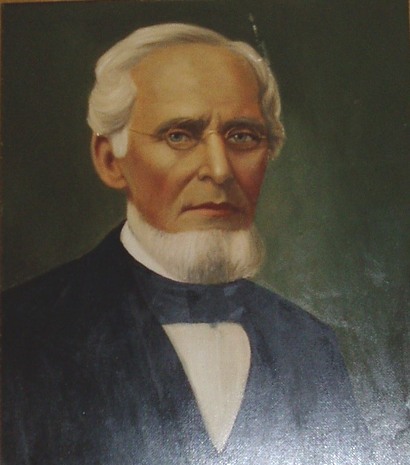|
A
New Yorker who grew up in Indiana, Gail Borden came
to Texas in 1829, five years after his
brother Thomas arrived as one of Stephen
F. Austin’s colonists.
Lacking much formal education, Gail learned by reading and doing.
He and his brother worked at first as surveyors, with Gail eventually
becoming the equivalent of a tax collector in the provisional government
of Texas.
Border knew metes and bounds, but nothing about the newspaper business.
Still, he realized Texas needed a voice.
Since the brief appearance of the Gaceta de Texas in 1813,
only nine newspapers had been published in Texas. Just one sheet,
The Texas Republican, enjoyed any significant circulation when
Borden decided to venture into publishing in 1835.
With a R. Hoe and Company medium hand press purchased in Cincinnati,
the Borden brothers and partner Joseph Baker printed their first issue
on October 10, 1835 at San
Felipe de Austin.
On page two of the eight-page inaugural issue, Borden explained: “We
shall...endeavor to make our paper what its title indicates, the organ
by which the most important news is communicated to the people, and
a faithful register of passing events.”
The Telegraph and Texas Register quickly became the best read
and most authoritative paper in Texas.
In just two months it claimed a circulation of 500.
The printing press, Borden opined in his November 7 issue, was among
“the greatest and most important inventions of man” if used to improve
and enlighten the world, but if employed otherwise “it is productive
of the greatest evil.”
Borden’s newspaper went on to play a critical part in the Texas revolution,
but true to his philosophy, Borden did not fan the flames. Instead,
he and his partners printed stuck to the facts as best they could.
“It has never been the object of this paper to forestall public opinion,
and to crowd upon the people our own views in a matter so important
as that touching a change of government,” Borden editorialized. |
 |
Oil
Portrait of Gail Borden
Photo of Portrait courtesy Karen Ross |
On February
20, 1836, the newspaper reported that General Antonio Lopez de Santa
Anna was on his way to Texas with thousands of troops. He had promised,
the Bordens wrote, “to leave nothing of us but the recollection that
we once existed.”
The newspaper served as a medium of communication for the revolutionary
government as well as preserving the history of the struggle. The
Bordens printed many public documents, including 1,000 copies of a
handbill containing the text of William
B. Travis’ last letter from the Alamo.
The letter itself has not survived, but enough copies of the handbill
made it through the revolution to save Travis’ words for posterity.
Borden learned on March 17 that the Alamo
had fallen. The Texas Republican having suspended publication,
the Telegraph was the first newspaper to report the grim news that
Santa Anna had overrun the old mission and killed every defender.
The provisional government and its citizens soon undertook a general
flight eastward, the Mexican Army not far behind.
The Bordens remained in San
Felipe for the time being, reporting more details of the Alamo
in their March 24 edition. Three days later, realizing they were the
only source of information left, they joined the flight. They got
help in crossing the Brazos with their press and type cases from the
Texas military. From the east side of the rain-swollen river, Borden
watched San
Felipe – and his print shop – go up in smoke as the Texas rear
guard torched the village.
The Bordens set up shop in Harrisburg, on Buffalo Bayou, and started
working on another issue. “We promise the public of our beloved country
that our press will never cease its operations til our silence shall
announce…that there is no more in Texas
a resting place for a free press nor for the government of their choice,”
Borden wrote in the April 14, 1836 issue.
Only six copies of the Telegraph had been printed before Mexican
soldiers burst into the office, seizing the press. Grabbing what they
had printed so far, the Bordens managed to escape by boat for Galveston,
where the government had gathered.
The Mexicans burned the town and sank the press and all the type in
Bray’s Bayou. A week later, Sam
Houston’s army defeated Santa Anna at San
Jacinto, but Borden had no press to tell the story.
In July, with a new press purchased on credit in New Orleans, the
Bordens relocated to the republic’s new capital, Columbia,
a small town on the west bank of the Brazos. With the first session
of Congress to convene there that fall, the first issue of the Telegraph
in its new location came out on August 2.
With new partners, Borden continued his association with the newspapers
until June 20, 1837 when he left Texas,
eventually to make another contribution to society – he invented canned
milk.
During a 20-month period, Borden had produced 74 editions, chronicling
some of the most important events in Texas history. Texas historian
Dr. Joe B. Frantz summed up the pioneer newspaper publisher’s philosophy
in 12 words: “He believed in a free press, but also in a free public.”
Author’s note:
Like Borden’s milk, this column is a condensation of an essay on the
Texas Telegraph and Register I wrote for “The News in Texas,” a book
published in 2005 by the University of Texas Press for the Center
for American History.
© Mike Cox
"Texas Tales" March
5 , 2009 column |
|
|
